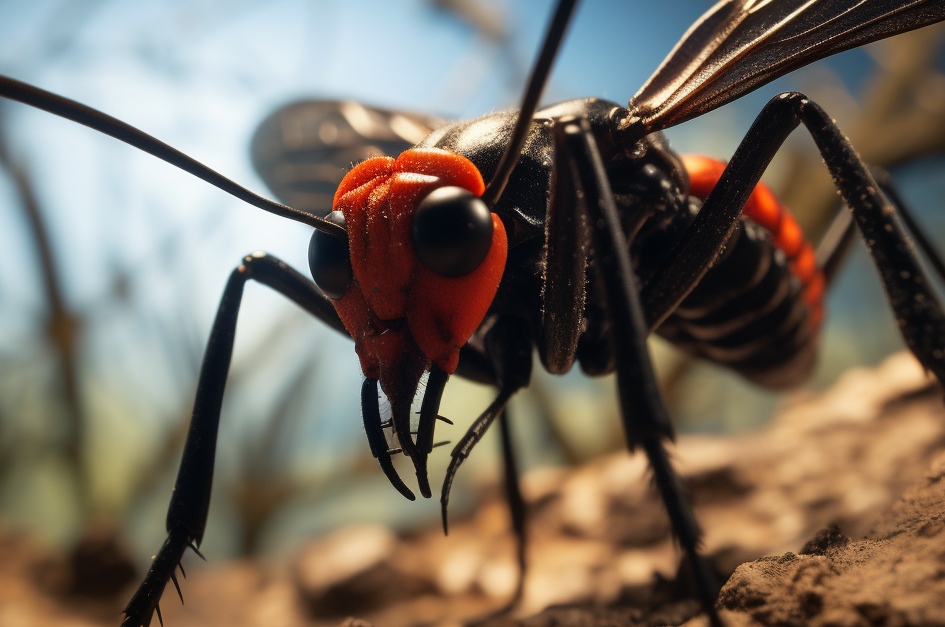What's New At Evans Pest Control
Learn more about Evans Pest Control capabilities
The Tarantula Hawk – Experts agree that the best way to handle the sting of the tarantula hawk is to lay down and scream.
The Tarantula Hawk – Experts agree that the best way to handle the sting of the tarantula hawk is to lay down and scream.
This wasp that preys on tarantulas is thought to have the world’s 2nd most painful sting. This large spider wasp is a fascinating and intimidating insect known for its aggressive demeanor, its unique predatory behavior towards tarantulas, and its intriguing life cycle. Here's a detailed description of each aspect:
1. Sting of a Tarantula Hawk:
The sting of a tarantula hawk is infamous for being one of the most painful insect stings in the world. It is often ranked at the top of the Schmidt Sting Pain Index, a scale created by entomologist Justin Schmidt to describe the pain associated with various insect stings. The pain from a tarantula hawk sting has been described as excruciating, intense, and incapacitating. The sensation is often compared to electric shocks or being struck by a hammer. Victims typically experience severe, throbbing pain that can last for several minutes, followed by lingering discomfort for hours or even days. The pain is so intense that it can temporarily paralyze a tarantula, which is the primary target of the tarantula hawk's sting.
2. Predatory Behavior:
The tarantula hawk is a type of parasitoid wasp that preys on tarantulas, particularly large species found in arid regions of the Americas. The female tarantula hawk is the hunter, and her approach to capturing tarantulas is both strategic and gruesome:
Locating a Tarantula: Female tarantula hawks have excellent vision and can spot tarantulas on the ground. They often patrol the areas where tarantulas are known to reside.
Stinging and Paralyzing: When a tarantula hawk identifies a tarantula, it will engage in a dramatic aerial battle. Once it lands on the ground, it approaches the tarantula with caution. When the tarantula tries to defend itself, the wasp delivers a paralyzing sting, typically to the underside of the tarantula's abdomen. The venom from the sting quickly immobilizes the tarantula, rendering it helpless but still alive.
Egg Laying: With the tarantula paralyzed, the tarantula hawk then lays a single egg on the tarantula's abdomen. The wasp's larva will eventually hatch from this egg and feed on the still-living tarantula.
Protection from Predators: The tarantula hawk often takes care to drag the paralyzed tarantula to a suitable burrow or nest, which it has previously prepared. The tarantula is placed in the burrow, and the wasp seals it inside with a mixture of mud and pebbles. This provides both protection and a source of fresh food for the developing wasp larva.
3. Life Cycle:
The life cycle of a tarantula hawk is a remarkable example of parasitism and predation:
Egg Stage: After the female tarantula hawk lays her egg on the tarantula, the larva hatches from the egg within a few days. At this stage, it begins feeding on the paralyzed tarantula's body fluids and soft tissues.
Pupal Stage: As the larva grows, it continues to feed on the tarantula, eventually consuming its internal organs. After several weeks, the larva reaches full maturity and forms a pupa inside the tarantula's exoskeleton.
Adult Emergence: When the pupation process is complete, an adult tarantula hawk emerges from the pupal case. It then exits the tarantula burrow, leaving behind the lifeless husk of its host.
Reproductive Cycle: Adult tarantula hawks, which are sexually dimorphic, with females being larger than males, feed primarily on nectar and plant juices. Males are responsible for finding females and mating. Once mated, female tarantula hawks seek out tarantulas to continue the cycle.
Fortunately, here in Philadelphia we may have some aggressive predator rats, but nothing like the formidable tarantula hawk. Philadelphia urban pests include rodents, and many types of bees, hornets, and wasps but nothing like the tarantula hawk whose sting is known for its excruciating pain, making it one of the most formidable predators in the insect world. In Philadelphia, pests are bad enough here that having a pest control expert on your contact list is a good idea. If you run into a tarantula hawk, or even a fast-moving roach, consider keeping Evans Pest Control in mind. We are well reviewed with a long history of partnering with residential and commercial clients to keep their environments safe and sound.
Get a Free Phone Consultation
Having a bug problem? Talk to a professional right now!
Yes, We Can Help
Drop us a message and we will help you today!

